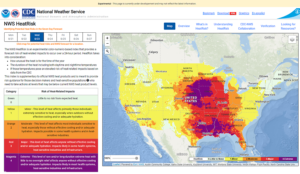NOAA is expanding the availability of a new experimental heat tool called HeatRisk ahead of the summer months of 2024.
HeatRisk
A collaboration with NOAA’s National Weather Service (NWS) and the Centers for Disease Control and Prevention (CDC), HeatRisk provides information and guidance for those who are particularly vulnerable to heat and may need to take extra precautions for their health when the temperature rises.
HeatRisk provides historical context for high-temperature forecasts, identifying how unusual the heat will be for any given time of year across a spatial area with coverage across the contiguous USA. It also identifies temperatures that are expected to bring increased heat impacts over a 24-hour period, up to seven days in advance.
The tool takes into account the cumulative impacts of heat by identifying the expected duration of the heat, including both daytime and nighttime temperatures. HeatRisk is divided into a number and color-coded scale – ranging from zero to four and minor to extreme – that identifies the risk of heat-related impacts.

Extreme heat
“Climate change is causing more frequent and intense heat waves that are longer in duration, resulting in nearly 1,220 deaths each year in the US alone,” said NOAA administrator Rick Spinrad. “Last year was the warmest year on record for the globe, and we just experienced the warmest winter on record. HeatRisk is arriving just in time to help everyone, including heat-sensitive populations, prepare and plan for the dangers of extreme heat.”
“Heat can impact our health, but heat-related illness and death are preventable,” said CDC director Mandy Cohen. “We are releasing new heat and health tools and guidance to help people take simple steps to stay safe in the heat.”
NWS developed the first HeatRisk prototype for California in 2013 and expanded it to the Western USA in 2017. While HeatRisk thresholds in the first prototype were based on local climate trends, the thresholds now also include heat-health impact information from the CDC. HeatRisk is available across the contiguous USA as an experimental product while NWS accepts feedback from the public.
In related news, CAPA Strategies and NOAA’s National Integrated Heat Health Information System (NIHHIS) recently began accepting applications from organizations interested in participating in the 2024 Urban Heat Island (UHI) mapping campaign program. Click here to read the full story.



